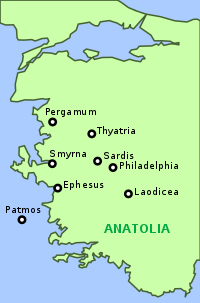
The Hebrew term Abaddon, and its Greek equivalent Apollyon appear in the Bible as both a place of destruction and an angel of the abyss. In the Hebrew Bible, abaddon is used with reference to a bottomless pit, often appearing alongside the place Sheol, meaning the resting place of dead peoples.
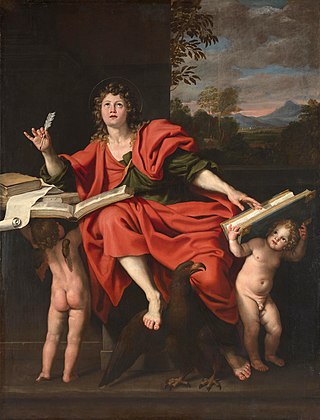
The Book of Revelation or Book of the Apocalypse is the final book of the New Testament. Written in Koine Greek, its title is derived from the first word of the text: apokalypsis, meaning 'unveiling' or 'revelation'. The Book of Revelation is the only apocalyptic book in the New Testament canon. It occupies a central place in Christian eschatology.
Christian eschatology is a minor branch of study within Christian theology which deals with the doctrine of the "last things", especially the Second Coming of Christ, or Parousia. Eschatology – the word derives from two Greek roots meaning "last" (ἔσχατος) and "study" (-λογία) – involves the study of "end things", whether of the end of an individual life, of the end of the age, of the end of the world, or of the nature of the Kingdom of God. Broadly speaking, Christian eschatology focuses on the ultimate destiny of individual souls and of the entire created order, based primarily upon biblical texts within the Old and New Testaments. Christian eschatology looks to study and discuss matters such as death and the afterlife, Heaven and Hell, the Second Coming of Jesus, the resurrection of the dead, the rapture, the tribulation, millennialism, the end of the world, the Last Judgment, and the New Heaven and New Earth in the world to come.
The New Testament (NT) is the second division of the Christian biblical canon. It discusses the teachings and person of Jesus, as well as events relating to first-century Christianity. The New Testament's background, the first division of the Christian Bible, is called the Old Testament, which is based primarily upon the Hebrew Bible; together they are regarded as Sacred Scripture by Christians.
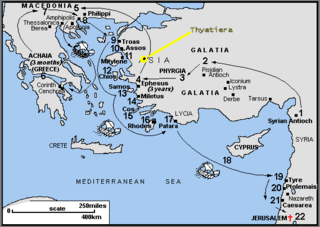
Thyateira was the name of an ancient Greek city in Asia Minor, now the modern Turkish city of Akhisar, Manisa Province. The name is probably Lydian. It lies in the far west of Turkey, south of Istanbul and almost due east of Athens. It is about 50 miles (80 km) from the Aegean Sea.
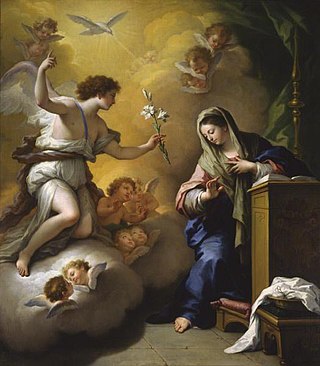
Archangels are the second-lowest rank of angel in the Christian hierarchy of angels, put forward by Pseudo-Dionysius the Areopagite in the 5th or 6th century in his book De Coelesti Hierarchia. The word "archangel" itself is usually associated with the Abrahamic religions, but beings that are very similar to archangels are found in a number of other religious traditions.
Dispensationalism is a theological framework of interpreting the Bible which maintains that history is divided into multiple ages or "dispensations" in which God acts with his chosen people in different ways. It is often distinguished from covenant theology. These are two competing frameworks of Biblical Theology that attempt to explain the continuity of the Bible as a whole. The term "dispensationalism" is attributed to Philip Mauro, a critic of the system's teachings in his 1928 book The Gospel of the Kingdom.
The catholic epistles are seven epistles of the New Testament. Listed in order of their appearance in the New Testament, the catholic epistles are:

The events of Revelation are the events that occur in the Book of Revelation of the New Testament. An outline follows below, chapter by chapter.

The concept of Seven Archangels is found in some works of early Jewish literature and in Christianity. In those texts, they are referenced as the angels who serve God directly.

Lydia of Thyatira is a woman mentioned in the New Testament who is regarded as the first documented convert to Christianity in Europe. Several Christian denominations have designated her a saint.
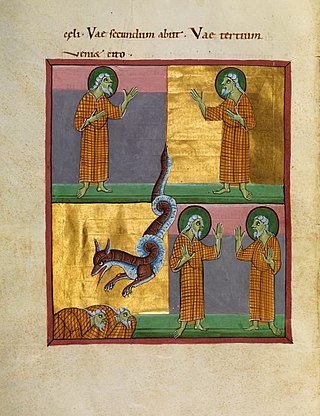
In the Book of Revelation, the two witnesses are two prophets who are mentioned in Revelation 11:1-14. Some Christians interpret this as two people, two groups of people, or two concepts. Some believe they are Enoch and Elijah, as in the Gospel of Nicodemus, since they are the only two that did not see death as required by the Scriptures, while others believe them to be Moses and Elijah because they appeared during the transfiguration of Jesus, or because Enoch was not Abraham's descendant. They have the power to shut the heavens (Elijah) and turn water into blood (Moses).
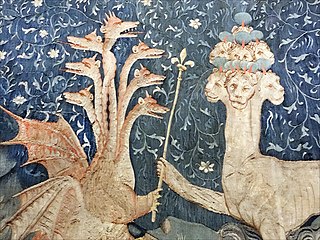
The Beast may refer to one of three beasts described in the Book of Revelation.

In the Bible, the term Seven Spirits of God appears four times in the Book of Revelation. The meaning of this term has been interpreted in multiple ways.

John's vision of the Son of Man, also known as John’s Vision of Christ, is a vision described in the Book of Revelation in which the author, identified as John, sees a person he describes as one "like the Son of Man". The Son of Man is portrayed in this vision as having a robe with a golden sash, white hair, eyes like blazing fire, feet like bronze and a voice like rushing waters. He holds seven stars in his right hand and has a double-edged sword coming out of his mouth. The vision is interpreted by Christians as the only identifiable physical description of Jesus in any form in the Christian biblical canon.

Revelation 1 is the first chapter of the Book of Revelation or the Apocalypse of John in the New Testament of the Christian Bible. The book is traditionally attributed to John the Apostle, but the precise identity of the author is a point of academic debate. This chapter contains the prologue of the book, followed by the vision and commission of John.
The canon of the New Testament is the set of books many modern Christians regard as divinely inspired and constituting the New Testament of the Christian Bible. For most churches, the canon is an agreed-upon list of 27 books that includes the canonical Gospels, Acts, letters attributed to various apostles, and Revelation.

Revelation 2 is the second chapter of the Book of Revelation or the Apocalypse of John in the New Testament of the Christian Bible. The book is traditionally attributed to John the Apostle, but the precise identity of the author remains a point of academic debate. This chapter contains messages to churches of Ephesus, Smyrna, Pergamum and Thyatira, four of the seven churches of Asia located in modern-day Turkey, with messages for the other three churches appearing in chapter 3.

Revelation 8 is the eighth chapter of the Book of Revelation or the Apocalypse of John in the New Testament of the Christian Bible. The book is traditionally attributed to John the Apostle, but the precise identity of the author remains a point of academic debate.

Revelation 15 is the fifteenth chapter of the Book of Revelation or the Apocalypse of John in the New Testament of the Christian Bible. The book is traditionally attributed to John the Apostle, but the precise identity of the author remains a point of academic debate. This chapter includes the hymn of Moses and the Lamb and introduces the seven angels who appear with seven plagues.
